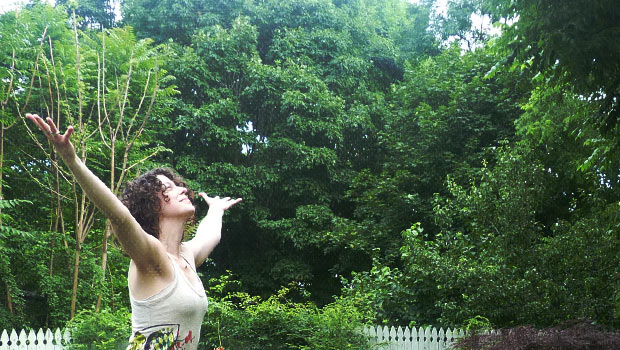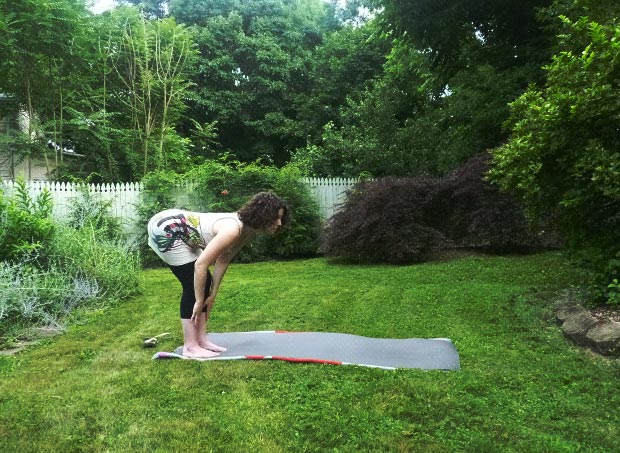Over the past 11 months, I’ve been dealing with Patellofemoral Syndrome and ongoing pain and swelling in my right knee. I plan on writing much more about my journey to recovery and what I’ve learned along the way, but today I want to focus on a simple vinyasa practice that has helped me through this trying time.

The following yoga sequence is intended for those in recovery or with minor aches and pains; Its focus is on building or maintaining strength and flexibility without putting significant weight on the bent knee. Poses like the warrior asanas (Virabhadrasana 1 and 2), low lunge (anjaneyasana), hero (virasana) and even child’s pose (balasana) put immense pressure on the knee joint, and for practitioners experiencing knee pain or injury, these poses can be excruciating and exacerbate any issues. I’ve learned this first-hand, and this modification of Surya Namaskar A removes any stepping forward or back, thus allowing the legs to remain mostly* straight.
Another benefit of removing lunges and stepping is that the pelvis remains even, so this sequence is also very symmetrical for the hips. If you’ve been managing knee pain in only one knee for a significant amount of time, it is likely that your hips have been affected. We rely on our knees to walk properly, so if injury causes us to compensate by walking incorrectly, it affects the opposite leg, feet, and hips. Over time, this can affect the spine and neck, as well. It truly is all connected! So, symmetry in the legs and hips paired with optimal stretching can help prevent as well as correct these issues.
If you’re experiencing acute pain or swelling in the knee—or anywhere else, for that matter—you should see a doctor and avoid practicing until you have a clear understanding of what’s happening in your body and its limitations. Remember that every body and every experience in asana is personal and unique, so understand that these are my suggestions from my own experience and may not work for your situation. As always with yoga, if something doesn’t feel right, stop. Never push and always listen to your body.
*Note: Some bending of the knees may be required to allow for tight hamstrings in forward bend and Downward-Facing Dog. If this is too much for your knee(s), this sequence may not work for you.
Surya Namaskar A – Step-Free Variation

Tadasana. Begin standing, feet hip-width apart, at the back of your mat. Direct your attention to the soles of your feet, feeling a solid connection to the Earth at the ball of your foot, base of the pinky toe, and both sides of the heel. Energetically extend your feet into the ground, feeling a sense of sturdiness in the legs as you engage the muscles, lift up on the knee caps (only without pain) and beef up your thighs. Let your pelvis remain neutral, but engage the pit of your belly, let the spine grow tall, and relax the shoulders down and away from your ears. Let the arms float out to your sides, feeling a lightness in them as you fill your lungs with deep, free breathing.

Urdhva Hastasana. Let your in-breath rise your arms up overhead, slowly feeling each and every inch of the movement. Reach to the sky.

Uttanasana. As you slowly exhale, put a small bend in your knees and lengthen your spine forward from the hips. Reach your arms out to the side and down as you fold towards your legs, adjusting the bend in your knees as is comfortable. Allow your breath to fill the entire motion, so that your hands come to your shins or the floor just as you finish your exhale.

Ardha Uttanasana. Inhale your heart forward, letting your spine straighten as your fingertips remain on your shins or the mat. Lift your gaze but keep your neck soft.
Uttanasana. Exhales as you fold back into your thighs.

Adho Mukha Svanasana. Bend your knees as much as needed to place your palms on the floor. As you inhale, slowly walk your hands to the front of your mat, finding your down-dog. Spread the fingers fully; ground through the full circumference of you hands. Roll the underside of your upper arms in to externally rotate your arm bones. If you feel any rounding in your spine, put a soft bend in the knees. Lengthen your hips up and away to find as much space and freedom in your spine. Spread your toes, and reach your heels toward the mat or remain on the balls of your feet. Breathe deeply into your back body, allowing your face to soften and neck to relax toward the ground. Stay for five long breaths.
Vinyasa Sequence, optional. *Skip these steps if you feel weak in the arms/upper body and are unable to drop to your knees for the modified version.

Chaturanga Dandasana*. Inhale as you round into your upper spine, pressing down into your palms as you transition to plank pose, lowering your hips as you firm your core and park your elbows over your wrists. Distribute your weight through all 10 fingers and hover your body level with the floor. Then, exhale as you cinch your elbows into your ribs and lower to the floor.
Modification: Drop your knees during this transition, so long as there is no pressure or pain. You may want to add extra padding for the knees, such as a blanket or piece of an old yoga mat.

Bhujangasana*. Keeping the elbows at your sides and palms pressing to the earth, engage the legs by pressing the tops of the feet and pelvis into the ground as you inhale to lift your head and shoulders away from the floor. Breathe fully into the chest, relaxing the neck and shoulders; firm the belly. Exhale back down.
Adho Mukha Svanasana*. Press into the hands, bend the knees, and lift your hips up and back, returning to downward-facing dog. Let your head hang heavily as you exhale fully. Take another full breath in and out to lengthen and decompress the spine.
Uttanasana. Bend your knees more, so that you can walk your hands back to your feet, returning to uttanasana. Exhale as your fold into yourself. Keep your legs and face soft.
Ardha Uttanasana. Inhale to lengthen your spine forward, keeping your fingertips on the mat or placing palms on the shins.
Urdhva Hastasana. Put a small bend in your knees, engage your belly, and press down through your feet as your sweep your arms up and come back to standing, palms touching overhead.

Tadasana. Soften your shoulders, and exhale as you trace your hands down the midline and in front of your heart. Return to a strong foundation and keep a lightness in your chest.
Repeat 3-5 times before moving on to the rest of your practice. Namaste.

Great to see this Raeanne! Thanks for sharing. :-)
Hello I have the same pain and I was also diagnosed with it also 11 months ago. Does it ever cure. I am so depressed.
Hello Yomna,
I feel for you! I encourage you to look into the work of functional medical doctors like Chris Kresser, Terry Wahls, Amy Meyers and Sarah Ballantyne. They each offer varied but similar approaches to treating autoimmune disease naturally through dietary and lifestyle changes, and I am feeling much better these days. It is certainly a journey, but well worth it.
Good luck to you.
Raeanne
Hey there…many thanks for this useful piece of advice….just was curious to know whether would this variation within Surya namaskar effectively and sufficiently help burn the fat on thighs and hip area….please answer this one as I’m really looking forward to practice this version of Surya namaskara….
Thanks & Regards